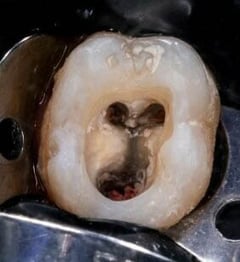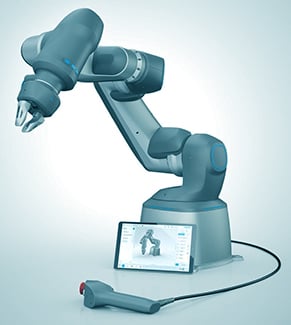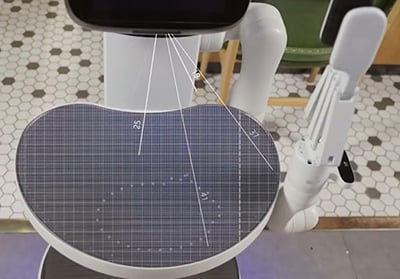What’s New in Robotics? 20.05.2022

Posted on May 20, 2022 9:30 AM. 7 min read time
News briefs for the week take a look at nanobots that repair human teeth, world’s first-ever all-pneumatic cobot, Pudu Robotics adds a utility arm to its restaurant food server, the growing “new” fear in not having enough robots, Sarcos Robotics buys RE2 and gains greater presence in construction industry.

Teeny Robots for Teeth
A root canal, plus a crown to recap the tooth after the procedure, can cost between $1800 and $5000 in North America. In the U.S. alone, some 22 million root canals are performed annually.
 Is there a faster, better, cheaper way? Enter, nano-size robots for deep dives into a tooth’s dental canals.
Is there a faster, better, cheaper way? Enter, nano-size robots for deep dives into a tooth’s dental canals.
Dental nanorobots or nanobots are specialty hardware from Bangalore, India-based Theranautilus. In fact, the company claims to be the only maker of such teeny robots worldwide.
“The dentinal tubules are very small, and bacteria reside deep in the tissue. Current techniques are not efficient enough to go all the way inside and kill the bacteria,” explained Shanmukh Srinivas, co-founder of Theranautilus.
 Theranautilus has developed a helical nanobot made of silicon dioxide coated with iron, which can be controlled using a low intensity magnetic field. The nanobot enters the tooth canals with antibiotics to kill off bacteria and, alternatively, can be heated to also kill off bacteria.
Theranautilus has developed a helical nanobot made of silicon dioxide coated with iron, which can be controlled using a low intensity magnetic field. The nanobot enters the tooth canals with antibiotics to kill off bacteria and, alternatively, can be heated to also kill off bacteria.
“By tweaking the frequency of the magnetic field, the researchers were able to make the nanobots move at will, and penetrate deep inside the dentinal tubules. “We have also established that we can retrieve them … we can pull them back out of the patient’s teeth,” says Srinivas.”
Festo intros first-ever “pneumatic” cobot
Why, with more than 150 cobots from dozens of differing manufacturers already in the marketplace, does Festo introduce yet another?
This one is different, and for a good reason, says the Esslingen, Germany-based Festo. For one thing, lower cost, explains Festo board member Dr Frank Melzer. Ease of programming is another, and the flexibility of this first-ever pneumatic cobot is a third reason.
Other than being a pneumatic drive, there may be more than a few cobot makers that will take exception to the low price and ease of programming aspects. Of course, the marketplace will be the ultimate judge, and that won’t happen until full introduction of the cobot in 2023.
 Festo expects that its trio of cited reasons will appeal to SMEs, and offers four target applications: “labelling and tagging is one, especially where soft materials are involved; autonomous machine tending; loading and unloading, especially for applications such as PCB testing; and de-powdering operations requiring complex movements in applications such as 3D printing and painting.”
Festo expects that its trio of cited reasons will appeal to SMEs, and offers four target applications: “labelling and tagging is one, especially where soft materials are involved; autonomous machine tending; loading and unloading, especially for applications such as PCB testing; and de-powdering operations requiring complex movements in applications such as 3D printing and painting.”
“Unlike electric drives,” writes Drives & Controls, “the six pneumatic direct drives in the cobot’s articulated joints do not need heavy gearboxes or expensive force-torque sensors, that cutting costs and weight. The pneumatic drives allow the arm to be guided by hand without any resistance so that waypoints or paths can be taught quickly and precisely.”
On the other hand, “If not cared for properly, pneumatic systems can have short lifespans due to a hidden problem: Condensation.” Moisture can build up inside pneumatic pipes that can compromise the functionality of the robot and affect how long the equipment lasts.
How the new cobot will ultimately shake out in the market will get clearer come 2023.
PUDU server robot adds utility arm
Shenzhen-based Pudu Robotics, since its founding in 2016, has been on a mission to dominate restaurant food serving robotics as well as delivery and cleaning robotics for the hospitality industry. It’s fleet of various service robots easily attest to its ongoing R&D, product  releases and general fervor on that multi-billion-dollar global front.
releases and general fervor on that multi-billion-dollar global front.
Long expected but just recently accomplished sees Pudu adding a utility arm to its restaurant server robot. Called the PUDU A1, it’s akin to its BellaBot or PuduBot food server robots growing an articulated arm.
PUDU A1, says the company, is its first compound delivery robot designed to bridge “the divide between the kitchen and the dining table.” The PUDU 1A leverages the company's technologies for food recognition, positioning and grasping technology, laser SLAM and visual SLAM.”
The PUDU A1 can identify different food types being served, and with PUDU's visual positioning and grasping technology, “the mechanical arm can accurately locate the plates in real time and grip correctly to ensure transfer to the designated table through communication with the restaurant's management system.”
Suddenly, robots warmly welcomed. What’s up?
Since January of 2020, a perfect storm has whipped up over society that augers well for evermore robots to join the rest of us at work, home, at play and at your service.
Todd Bishop’s recent GeekWire headline says it all: We’ve literally run out of human beings: Robots rise in wake of pandemic and labor shortages.
 “The robots are here,” writes Bishop, “but they’re not yet fully present in our lives. And suddenly, in many parts of the economy and society, they can’t show up quickly enough.”
“The robots are here,” writes Bishop, “but they’re not yet fully present in our lives. And suddenly, in many parts of the economy and society, they can’t show up quickly enough.”
“The biggest shift that has happened from 2018 to now is that we’ve literally run out of human beings to do the things that we need to do,” said roboticist Siddhartha “Sidd” Srinivasa, who founded Carnegie Mellon University’s Personal Robotics Lab during his 18-year tenure in Pittsburgh.
That shift, says Bishop’s article, is giving a new spark to robotics engineers and entrepreneurs who have long aspired to change the world with their inventions and ideas.
But it’s not just about backfilling roles once held by human workers. Robotic systems offer the potential to free people up for higher-level or more meaningful activities, said Henny Admoni, an assistant professor at CMU who directs the Human and Robot Partners (HARP) Lab.
Look for adverse reactions to simmer down even more as industrial and logistics robots begin a long-awaited acceptance by humans, as they enter workplaces in ever-increasing numbers.
Sarcos Robotics buys RE2 Robotics for $100M
Salt Lake City-based Sarcos Robotics, manufacturer of multiple lines of exoskeletons, mostly as aids for workers in the construction industry, ponied up $100 million to acquire Pittsburgh-based RE2 Robotics, which has sold over 600 robotic arms (since 2010) and does $15 million in revenue annually.
 Benefits for both will RE2’s existing deals with the U.S. government to develop robotic systems for underwater and industrial uses, and more opportunity for Sarcos acquiring a greater presence in construction.
Benefits for both will RE2’s existing deals with the U.S. government to develop robotic systems for underwater and industrial uses, and more opportunity for Sarcos acquiring a greater presence in construction.
Part of that expansion will see benefits through the Sarcos deal with T-Mobile to bring 5G to both company’s robots for increased teleoperation.
Sacros is particularly flushed with cash these days after going public, which freed up an immediate cash reserve of $496 million. More expansion through acquisition is still a possibility.
As Frank Nerenhausen, EVP of Oshkosh Corporation, noted about the deal: “A large focal area in construction and industrial applications today is remote operation of equipment that keeps workers out of harm’s way,” which goes to reinforce the notion of the potential impact of both companies in construction…on land and subsea.
“They’re planning on building machines that act more than extensions of their human operators than freethinking and free-moving autonomous agents,” reports VentureBeat.


Leave a comment